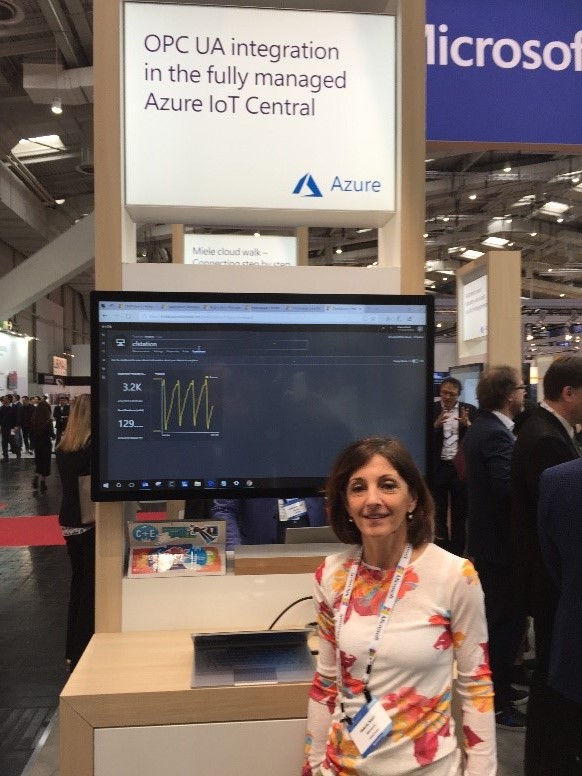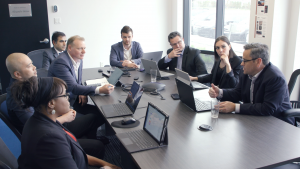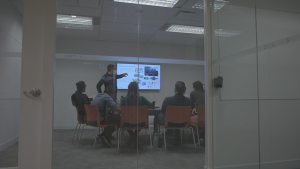
Microsoft Canada at Hannover Messe 2018
Germany – the land of automotive excellence, great beer, fairytale castles, and the world’s largest industrial trade show – Hannover Messe. Attracting over 250,000 visitors, this massive event brings together everyone who’s anyone in manufacturing and industry, and this year was no exception.
On a personal note, it was especially exciting for me because this was my very first time attending the show. Even though I’ve been in the industry for decades (I was the Desktop Development Lead on Honeywell’s industrial historian 25 years ago), I have never been able to attend– till this year. As a first-time attendee, I can tell you that the show is massive, overwhelming, and very exciting all at the same time. Protip – if you’re planning to go next year, make sure you book early. The hotels fill up fast.
Microsoft had a strong presence at the show, and here’s a summary of some of the great solutions we have for the manufacturing industry, along with some exciting new announcements.
Connected Factory

The most difficult part of any transformation can often be figuring out where to begin. I’ve spoken with many customers who all say the same thing – they see the potential inherent in digital transformation, they want to start doing it, but they are finding it very hard to figure out where to start!
To help with this, we came up with a Connected Factory IoT Solution Accelerator. This preconfigured solution lets you connect and monitor your industrial equipment and devices in the cloud—including your machines already operating on the factory floor.
The solution leverages Azure services including Azure IoT Hub and Azure Time Series Insights (more on this below). It also uses the OPC Foundation’s cross-platform OPC UA Net Standard Library reference stack for OPC UA connectivity, as well as a rich web portal with OPC UA server management capabilities, alarms processing and telemetry visualizations.
The web portal and the Azure Time-Series Insights can be used to quickly see trends in OPC UA telemetry data and see Overall Equipment Effectiveness (OEE) and several key performance indicators (KPIs) like number of units produced and energy consumption.
Microsoft announced a new OPC Global Discovery Server module for Microsoft Azure IoT Edge at HMI that will detect all OPC Servers and their related endpoints. The endpoints and their related security configuration can be viewed through the Connected Factory user interface. To ensure communications are secure, certificates can be retrieved from Microsoft Key Vault and sent directly to the OPC Server.
You can view a live demo here -> http://www.microsoftazureiotsuite.com/demos/connectedfactory
Azure Time Series Insights

Andrew Shannon and Chandrika Shankarnarayan from the Azure TSI team were at HMI to show some of the new TSI features such as a new tag hierarchy, the ability to save cold data to blob storage, and new JavaScript “widgets” that can be used to make impressive websites. Most of the customers I demoed TSI to had never seen it before and were quite impressed with it, particularly its speed. The demo powerful as it was showing millions of real-time windmill data points from one of my Calgary based customers, TransAlta Utilities.
Time series data—sensor readings taken at intervals—has traditionally been a challenge to store and analyze. Azure TSI makes this very easy, enabling manufacturers to use a single place for the long-term storage of this data – while being massively scalable and protected. Once the data is in the IoT Cloud, you can use it to obtain meaningful insights without worrying about the infrastructure required to host the data.
Learn more about Azure Time Series Insights here
OPC integration with fully managed Azure IoT Central
Valerie Naldi showed an interesting prototype of production OPC data in IoT Central. As IoT Central is a fully managed SaaS offering, this would be a very low-touch approach to visualize, analyze and alert on plant floor data. As a bonus, administrators can see OPC UA configuration data as well.

Azure Sphere
There are over 9 Billion Microcontroller Units (MCU) powered devices built and deployed every year. These tiny chips are the brain of intelligent devices, hosting compute, memory and storage in a space smaller than your thumbnail.
Connectivity goes both ways though. Devices that send data to the Internet can also receive data – and if incorrectly secured, these devices can become compromised by malicious actors. To mitigate this threat, Microsoft recently announced Azure Sphere, a platform for securing and powering this new class of IoT devices at the intelligent edge.
The platform consists of three elements – Azure Sphere Certified MCUs, the Azure Sphere OS, and the Azure Sphere Security Service.
This combination of on-device hardware and software with the power of the cloud provides processing power five times that of traditional MCUs, a highly secure operating system designed specifically for IoT as well as a turnkey cloud security service that will monitor and detect threats, and automatically update security protocols—providing lifetime protection for every Azure Sphere device.
As MCU chips proliferate, Azure Sphere will allow manufacturers to produce the next generation of connected devices while increasing IoT security at every level.
Learn more about Azure Sphere here
Azure IoT Edge
IoT in the cloud is extremely powerful, but not all analytics need to be managed in the cloud. There are use cases where you want a device to respond as quickly as possible to an anomaly, and not have to wait to hear back from a central service. Or, in bandwidth limited areas, there may be value in doing data aggregation and cleanup on the device, and only moving insights to the cloud.
Azure IoT Edge is made up of three components:
- IoT Edge modules are containers that run Azure services, 3rd party services, or your own code. They are deployed to IoT Edge devices and execute locally on those devices.
- The IoT Edge runtime runs on each IoT Edge device and manages the modules deployed to each device.
- A cloud-based interface enables you to remotely monitor and manage IoT Edge devices.
There are many IoT Edge devices available for all use cases. Here are just a few examples from the show floor.
| Dragonboard 410C |  |
| Raspberry Pi 3 Compute Module |  |
| Nexcom NISE 50-IoT |  |
Learn more about Azure IoT Edge
Closing
As I said at the beginning, I’ve been in the industry for more years than I care to remember. Over these years, I’ve seen some very distinct shifts in how manufacturing companies are doing business.
Today, most companies are moving their historians (industrial databases) to a hybrid on-prem/cloud model, thereby breaking it out of the traditional siloed structure. This has the knock-on effect of democratizing the data within the company, and roles that didn’t traditionally have access to these databases are now able to access it. Many companies are exploring how they can better use their existing data to create new applications or augment existing ones.
A similar story is playing out when it comes to device telemetry. I’m seeing an increasing shift in how companies are pushing this intelligence to the cloud, and using the data in ways that were simply not possible when they were limited to vendor-specific solutions.
Couple this data with Machine Learning and Predictive Algorithms, and you can see that we’re moving into a new world – it’s not just about doing things faster or more efficiently anymore. For the first time I can remember, technology is ahead of the business.
Hannover Messe was a great showcase of how the rate of change is accelerating rapidly, even in industries that traditionally moved relatively slowly. Microsoft is at the forefront of this acceleration, and I know that our solutions are getting even stronger as I write this!
I plant to be at Hannover Messe next year, and I hope to see you there as well.




